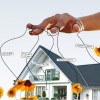CO2 Monitoring to Lower the Coronavirus Threat

There is increasing evidence that carbon dioxide levels in buildings correlate strongly with the airborne spread of infection. Consequently, CO2 monitors could act as the “canary in the coalmine” to mitigate the coronavirus threat.
Carbon dioxide is generated by the exhaled air of people who stay indoors. Alongside CO2 at a concentration around 40,000 parts per million (ppm), the exhalation also contains tiny liquid droplets (aerosols). These droplets will contain any virus particles present in the lungs. Research shows a method to mitigate infection can be implemented with CO2 monitors on site.
Whilst it is difficult to measure the viral load in the air directly, energy harvesting wireless sensors are the ideal way to monitor CO2 levels and hence prevent the build-up of reused air.
CO2 mass monitoring
Indoor CO2 measurements using easy and low-cost to install sensors hold promise for mass monitoring of indoor aerosol transmission risk for Covid-19 and other respiratory diseases. Different CO2 level targets should be set based on the environment and activity type, since infection risk level has been shown to vary by a factor of 100 or more depending on the situation and activity type.
Factors such as the number of infected people in a region, and measures such as mask-wearing or air filtration may reduce presence of the airborne virus without reducing CO2 levels. Certain activities increase virus emission far more than CO2 levels, such as talking, singing and shouting. Both CO2 and the virus are diluted by ventilation with outdoor air. They are not, however removed by recirculating the air, for example through heat exchangers. It is clear that CO2 measurement offers a cost-effective solution for classifying the current risk from potentially infectious aerosols.
Ventilation means not only air exchange, but also heat loss in winter. A sustainable strategy should also take this effect into account. Where there is no modern air-conditioning technology, only monitoring of the CO2 and demand-oriented or regular manual cross ventilation helps.
Read in the EnOcean magazine Perpetuum a feature on the Coronavirus – our partners report on their experiences and solutions in exciting case studies and interesting articles.
CO2 sensor implementation
To follow these strategies, CO2 monitoring devices need to be dependable, and easy to place where they are needed. Ideally, they need to be connected, for example to trigger alarms when CO2 concentration goes above “traffic light” thresholds, even to send alarms to building management networks, or to smartphones via wireless networks. Wireless, battery-free sensors represent the ideal solution. Simple to fit and easy to maintain, such sensors utilize energy harvesting technology to draw energy from their surroundings – for example from motion, light or temperature differences. Rapidly deployed, without the need for special installation or wiring, such solutions enable continuous monitoring of carbon dioxide concentration in the ambient air.
By sending measured values to a receiver or gateway for further processing, alarms can be triggered, and appropriate action initiated. For example, it is possible to start a room ventilation system in order to reduce the CO2 concentration. What is more, a wide range of these CO2 sensors work within the ecosystem of standards like the EnOcean Alliance. This means that they can easily combine with other devices, such as room occupancy sensors and access control, that are integral to COVID-19 measures.
Acknowledgements
- COVID-19 Prävention: CO2-Messung und bedarfsorientierte Lüftung – https://www.umwelt-campus.de/forschung/projekte/iot-werkstatt/ideen-zur-corona-krise
- Modelling aerosol transport and virus exposure with numerical simulations in relation to SARS-CoV-2 transmission by inhalation indoors – https://www.sciencedirect.com/science/article/pii/S0925753520302630#b0125



